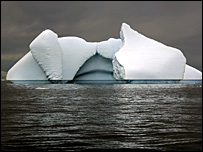

to Poorna Pal's Pages at the
Glendale Community College
Updated on 05.05.2015

Ocean 115: Physical Oceanography
 |
|
to Poorna Pal's Pages at the |
Updated on 05.05.2015 |
 |
||
|
Ocean 115: Physical Oceanography |
||||||
|
|
||||||
| for your | Home | My Book | Physical Geology: Geol-101, Geol-111 | Environmental Geology: Geol-102, Geol-112 | Oceanography: Ocean-115, Ocean-116 | ||
| Spring 07 Grades | |||
|
|
|
|
|||||||||||||||||
|
|
On this page: |
|
Click on this image on the left for Introduction to Physical Oceanography by Bob Stewart . | ||||||||||||||||
|
|
|
||||||||||||||||||
|
|
|
|
|||||||||||||||||
|
|
|
||||||||||||||||||
|
|
|||||||||||||||||||
This 3-unit "College Transfer" lecture course in the physical sciences examines the physical, chemical and geological aspects of oceans and the oceanic environment, in order to help you ...
|
|
describe how oceanography, perhaps the most visual of all physical sciences, exemplifies the scientific process of continually matching the empirical observations and theoretical constructs and helps us understand the forces that shape our natural environment; |
|
|
establish the oceanographic connections that bridge geology, meteorology, ecology, biology, physics, chemistry, economics and ethics; and |
|
|
explain why understanding the oceanic realm has become increasingly crucial to our collective future. |
In the process, it should also help sharpen your skills in critical reasoning and articulation.
|
News you can use |
 |
Polar ocean 'soaking up less CO2' |
Learn how global warming will affect the polar bear. |
|||||||||||||||||||
|
|
|
||||||||||||||||||||
|
|
Antarctic 'treasure trove' found | ||||||||||||||||||||
|
||||||||||||||||||||||
|
|
|||||||||||||||||||||||||||||||||||||||
|
Day
Class Schedule for Meetings, Tests and
the Final Exam (TTH 10.15-11.47 AM, SB-243) |
to print this schedule, click on |
|
Click on the PPT below to access my PowerPoint presentations and on PDF to access the handout for the corresponding lecture. |
|||||||||||||||||||||||||||||||||
|
|
Other Learning Resources |
||||||||||||||||||||||||||||||||
|
|
||||||||||||||||||||||||||||||||
|
|
|
|
|||||||||||||||||||||||||||||||
|
|
||||||||||||||||||||||||||||||||
|
|
|
|
|||||||||||||||||||||||||||||||
|
|
||||||||||||||||||||||||||||||||
|
|
|
|
|||||||||||||||||||||||||||||||
|
|
||||||||||||||||||||||||||||||||
|
|||||||||||||||||||||||||||||||||
|
Night Class Schedule for Meetings, Tests and the Final Exam. (T: 6.30-9.53 PM, SB-243) |
to print this schedule, click on |
|
Click on the PPT below to access my PowerPoint presentations and on PDF to access the handout for the corresponding lecture. |
|||||||||||||||||||||||||||||||||
|
|
Other Learning Resources |
||||||||||||||||||||||||||||||||
|
|
||||||||||||||||||||||||||||||||
|
|
|
|
|||||||||||||||||||||||||||||||
|
|
|
|
|
|
|||||||||||||||||||||
|
|
|
|
|
|
||||||||||||||||
|
|
|||||||||||||||||
|
||||||||||||||||||
|
|
Class Policies and the Grading Scheme:
|
 |
What do you want to learn about?
|
Poorna's PowerPoint
Presentations
|
|
||||||||||||||||||
|
|
|
||||||||||||
|
|||||||||||||
|
|
||||||||||||
|
|
||||||||||||
|
|||||||||||||
|
These documents are PDF files that require you to have the freely downloadable Adobe Reader.
|
|||||||||||||||||||||||||||||||||||||||||
|
|
||||||||||||||||||||||||||||||||||||||||
|
|
In order to understand and answer these:
|
|||||||||||||||||||||||||||||||||||||||||||||||||||||||||
|
|
||||||||||||||||||||||||||||||||||||||||||||||||||||||||
|
Visit these sites to learn more about ...
|
Some other interesting links:
|
||||||||||||||||||||||||||||||||||||||||||||||||||||||||
|
|
|
Southern California Wetlands Recovery Project The goal of the Southern California Wetlands Recovery Project is to accelerate the pace, the extent, and the effectiveness of coastal wetland restoration through developing and implementing a regional prioritization plan for the acquisition, restoration, and enhancement of Southern California's coastal wetlands and watersheds. Ultimately, the |
|
SCWRP's efforts will result in a long-term increase in the quantity and quality of the region's wetlands. Source: http://www.scwrp.org/ |
||
|
|
|
The College Policy on Academic Honesty (adopted by the Glendale Community College District Board of Trustees on 1/27/97)
College study is the process of acquainting students with values and procedures central to scholarship. All students are expected to do their own work. All forms of cheating and plagiarism are absolutely forbidden. This is the official policy of Glendale Community College.
The following behaviors serve as an operational description of student violations of academic honesty:
When a student engages in academic dishonesty, faculty have the options of requiring the student to see a college counselor; assigning a lower grade, including F or O, on the assignment in question; assigning a lower or failing (F) final grade in the course (or denying promotion from a non-credit course). Violations of this Policy will be reported to the Executive Vice President of Instruction and will become part of the Glendale College Cheating Incident file, unless the instructor finds compelling reasons not to report a violation. The Executive Vice President of Instruction may then impose sanctions authorized by Administrative Regulation 5420. The sanctions include, but are not limited to, issuing a reprimand, suspending the student for up to ten days of instruction, and/or requesting a hearing by the Campus Judicial Board to see if the student should be suspended, or permanently expelled from the college
The student has the
right of due process for all the above sanctions. |
Home | My Book | Physical Geol: Geol-101, Geol-111 | Environmental Geol: Geol-102, Geol-112 | Oceanography: Ocean-115, Ocean-116
This site was last updated on 05/05/15